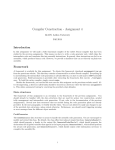Download Notes on Translating Three-Address Code to MIPS Assembly Code
Transcript
Notes on Translating Three-Address Code to MIPS
Assembly Code
Saumya Debray
Department of Computer Science
The University of Arizona, Tucson
1
1.1
Notes on the MIPS R2000
General Information
This document describes how to translate 3-address intermediate code to assembly code for the MIPS R2000
processor (as implemented by Jim Larus’s SPIM simulator).
Assembly code files should end with the suffix ‘.s’. The SPIM simulator reads in assembly source files,
so there is no need to translate to machine code.
Comments can be inserted in the assembler source: a comment is indicated by a ‘#’, and extends to the
end of the line. It is recommended that you generate comments giving three-address instructions together
with your assembly code to simplify debugging.
1.2
The Stack
A stack frame has the structure shown in Figure 1. The stack grows from high addresses towards low
addresses.
Two registers are relevant for stack management: the stack pointer $sp (register 29) and the frame pointer
$fp (register 30). The stack pointer $sp points to byte 0 (the high byte) of the top of the stack, i.e., the
next available word is at displacement 4($sp).
The return address is passed to the callee in register register 31.
1.3
General-Purpose Registers and Memory
The MIPS is a simple load/store architecture, i.e., arithmetic instructions typically operate only on registers.
It has 32 general-purpose registers of 32 bits each, numbered 0 through 31. In MIPS assembly language,
register i is written $i. The value of register 0 ($0) is always 0. Registers $1, $26, and $27 are reserved for
use by the assembler and the OS kernel. Registers $29 (stack pointer, $sp), $30 (frame pointer, $fp), and
$31 (return address register, $ra) are used for managing activation records and function calls/returns. The
results of integer-valued functions are returned in register $2 ($v0).
Memory is byte addressable in big-endian mode, with 32-bit addresses. All instructions are 32 bits long,
and must be aligned.
1.4
Byte Order
The SPIM simulator follows the byte order of the underlying processor. This means that on lectura, it is
big-endian. That is, byte 0 of a 4-byte word is the leftmost byte of that word (see Figure 1).
1
high addresses
0
byte no.
1
2
3
rightmost actual param
actual parameters
leftmost actual param
old $fp
$fp
old $ra
saved registers
saved registers
stack
growth
local variables
and temps
callee’s arguments
$sp
low addresses
Figure 1: Structure of a stack frame
2
Note that this may cause programs to produce different results if you run SPIM on a little-endian machine.
1.5
Using the SPIM Simulator
At this time, the SPIM simulator can be invoked on lectura by executing
/usr/local/bin/spim
The simulator will respond with the prompt ‘(spim)’, at which point various commands may be executed
as described in the SPIM user manual. Alternatively, you can use the X-window interface provided via the
command /usr/local/bin/xspim.
A typical interactive session might proceed as follows:
(1) Compile the source program into a MIPS assembly file, say prog.s.
(2) Invoke SPIM, as described above.
(3) Load and execute the program:
(spim) read "prog.s"
(spim) run
The run command, by default, causes execution of your program to start at label main. To exit the simulator,
type quit or ^D.
You can also “batch” the execution of a file, say prog.s, via the command spim -file prog.s.
2
2.1
Code Generation
Data and Text Segments
A set of data declarations must be preceded by the line
.data
A section of code (i.e., assembly instructions) must be preceded by
.text
Figure 2 gives an example of the use of these directives.
2.2
Identifiers and Labels
A global identifier id in the source program will translate to essentially the same identifier id in the assembly
code generated, though to avoid inadvertent conflicts with SPIM opcodes, it’s recommended that you add
an underscore ‘ ’ in front of each source identifier:
Helpful Hint 1: Append an underscore ‘ ’ in front of each source identifier before writing out
assembly code. Thus, a source code identifier ‘x’ is written out as ‘ x’ in the MIPS code
you generate. This avoids inadvertent name collisions between source program identifiers and
MIPS opcodes like ‘b’ and ‘j’.
3
Local variables will not map to identifiers, but will be accessed via displacements off the frame pointer.
In order to print string constants, it will be necessary to first declare the string, as discussed below, then
access that string using a label generated for it (note that this means that you have to keep track of which
label is associated with . which string).
A label is simply an identifier.
Keep in mind that while you will be compiling your program a function at a time, the simulator will
see all the labels and identifiers generated in the assembly code output. For this reason, you should be
careful to generate labels such that (i) no two compiler-generated labels will ever be in conflict; and (ii) a
compiler-generated label will be unlikely to conflict with an identifier from the user’s program. For example,
you might consider using a global counter for your labels, so that distinct labels use distinct counter values;
and have a leading and trailing pair of underscores on labels—e.g., produce labels such as ‘ 012 ’—to avoid
conflicts with user-defined identifiers.
2.3
Assembler Directives
Space for globals can be generated one identifier at a time. An identifier id that occupies n bytes of storage
is allocated as
id :
.space n
String constants can be defined using the .ascii and .asciiz directives, which store the strings listed in
memory as a sequence of characters. String constants declared using .ascii are not terminated with a 0
byte, while those declared using .asciiz are 0-terminated. Thus, the string constant "x = %d, y = %d\n"
can be defined by any of the following:
.ascii "x = %d, y = %d\12\0"
.ascii "x = %d, y = %d\n\0"
.asciiz "x = %d, y = %d\12"
.asciiz "x = %d, y = %d\n"
Finally, alignment restrictions can be enforced using the directive
.align n
which causes the next data/code to be loaded at an address divisible by 2n .
Example: Consider the following source program fragment, which declares several global variables, with the
corresponding assembler directives:
Source Program
char w;
Assembler Directive
.data
w: .space 1
.align 2
(the next variable must be 4-byte-aligned)
int x, a[12];
x:
.space 4
a:
.space 48
y:
.space 1
(12 ints @ 4 bytes each)
char y;
Code and data portions can be intermixed (as long as proper care is taken to align everything properly), as
shown in Figure 2.
4
int x;
.data
x: .space 4
y: .space 1
z: .space 1
.align 2
.text
foo:
char y, z
foo()
{
...
}
( code for foo )
.data
a: .space 40
int a[10];
.text
bar:
bar()
{
...
}
( code for bar )
Figure 2: An Example of Code Layout for a Program
2.4
Size Conversions
To load a 1-byte char variable at address addr into a 32-bit (sign-extended) value in register reg, use the
instruction ‘lb reg, addr’. To store a 32-bit value in register reg into a 1-byte char variable at address addr,
use the instruction ‘sb addr, reg’.
2.5
Accessing Memory
The way in which a memory location is accessed depends on whether it is a global or a local; and if a local,
then whether or not it is a formal parameter.
2.5.1
Accessing Globals
A scalar global variable can be accessed directly by name, e.g., to load an int variable x into register 5, we
can use
lw $5, x
An element of a global array can be accessed by computing its address and then accessing the contents of
this address. Thus, given a global array A of ints, suppose we want to access the value of the three-address
code expression A[i]. To do this, we generate
load the value of i into reg 1
la reg 2 , A
sll reg 1 , reg 1 , 2
add reg 2 , reg 2 , reg 1
lw reg 3 , (reg 2 )
/* load address of A into reg 2 */
/* scale by 4 */
If we are accessing a global array of char, the load instruction at the very end is ‘lb’ instead of ‘lw’.
5
The result is to leave the value of A[i] in reg 3 . Note that scaling is necessary only if the size of each
array element is greater than one byte. The code for storing a value into an array is similar, except that at
the very end we use a ‘sw’ or ‘sb’ (“store word/byte”) instruction instead of a ‘lw’ or ‘lb’ (“load word/byte”)
instruction (see Section 2.4).
A string constant can be accessed using the label associated with it.
2.5.2
Accessing Locals: 1. Actual Parameters
The parameter passing convention described here is considerably simpler (but not as efficient) as that described in the SPIM manual. Here, all parameters are passed on the stack, and the nth parameter to a
function (n ≥ 1, going from left to right) can be accessed from within the called function as k($fp), where
k = 4n + 4. For example, given a function with three parameters, the leftmost is at 8($fp), the middle
parameter is at 16($fp), and the rightmost is at 20($fp). Notice that, in Figure 1, the actuals are at higher
addresses than $fp. Because of this, actuals are accessed using positive offsets from $fp.
If a parameter is an array, then what is passed is a pointer to the first element of the array. In this case,
you have to load the contents of the corresponding memory location, then carry out the appropriate address
arithmetic to find the array element being referred to.
2.5.3
Accessing Locals: 2. Non-Parameter Variables
To access a local variable into a register, use the appropriate displacement off the frame pointer $fp: a
non-parameter local variable at displacement k from the frame pointer is accessed as ‘-k($fp)’. Notice that,
in Figure 1, the non-parameter local variables are below the frame pointer, i.e., at lower addresses than $fp.
Because of this, such variables are accessed using negative offsets from $fp.
Accessing a local array is analogous to that for global arrays, except that we begin by loading the starting
address of the array into a register explicitly, instead of using the name of the array variable. Thus, given a
local array A of ints that starts at displacement k from the frame pointer, suppose we want to access the
value of the three-address code expression A[i]. To do this, we generate
load the value of i into reg 1
la reg 2 , -k($fp)
sll reg 1 , reg 1 , 2
add reg 2 , reg 2 , reg 1
lw reg 3 , (reg 2 )
2.6
/* load address of A into reg 2 */
/* scale by 4 */
Loading Constant Values into Registers
A constant value n that is at most 16 bits wide (i.e., is less than 216 = 65, 536) can be loaded into a register
r using the li (“load immediate”) instruction:1
li r, n
A constant n that occupies between 16 and 32 bits wide can be loaded into a register r using the pair of
instructions
lui r, nhi
16
ori r, nlo
16
1 Strictly speaking, ‘li’ is a pseudo-instruction: the actual MIPS hardware doesn’t have this instruction; the assembler
translates the instruction ‘li r, n’ to ‘addi r, $0, n’.
6
lo
where nhi
16 denotes the high 16 bits of n and n16 denotes the low 16 bits of n. For example, suppose r ≡ $8
hi
and n ≡ 0xaabbccdd, then n16 ≡ 0xaabb and nlo
16 ≡ 0xccdd, and the necessary instruction sequence is:
lui $8, 0xaabb
ori $8, 0xccdd
2.7
Arithmetic Operations
Arithmetic operations are performed on registers. Shown below is a simple translation scheme (the SPIM
manual discusses instructions that are able to use immediate operands that are not more than 16 bits wide:
this optimization can result in somewhat more efficient code, but complicates the code generation process
somewhat):
x := y op z
load y into reg 1
load z into reg 2
opc reg 3 , reg 1 , reg 2
store reg 3 into x
load y into reg 1
neg reg 2 , reg 1
store reg 2 into x
x := -y
where, for op ∈ {+, -, *, /}, opc is, respectively, add, sub, mul, and div.
Note that multiplication by powers of 2, which is common when addressing array elements, can be done
using a sll (shift-left) instruction rather than the more expensive mul instruction.
2.8
Conditional and Unconditional Jumps
Unconditional and conditional control transfers can be implemented as follows:
goto L
if x op y goto L
j L
load x into reg 1
load y into reg 2
bcc reg 1 , reg 2 , L
the offset of L is at most ±226 bytes
the offset of L is about ±215 instructions
where the condition codes are given by the following:
op
<=
==
2.9
cc
le
eq
op
<
>
cc
lt
gt
op
!=
>=
cc
ne
ge
Arrays
The value of the ith element x[i] of a global array x, whose elements are 2n bytes wide, can be obtained by
load the value of i into reg 1
load the starting address of x into reg 2
sll reg 1 , reg 1 , n
(scale for element width: omit if n = 0)
add reg 2 , reg 1 , reg 2
{lw, lb} reg 3 , 0(reg 2 )
7
lw $4, j
la $5, x
sll $4, $4, 2
add $5, $4, $5
lw $6, ($5)
sw $6, -40($fp)
lw -40($fp), $4
lw $5, i
la $6, -24($fp)
add $6, $5, $6
sb $4, ($6)
#
#
#
#
#
$5 := start address of x
scale array index (x is an integer array)
$5 := address of x[j]
$6 := x[j]
tmp := x[j]
# $4 := tmp
# $6 := start address of y
# $6 := address of y[i])
# y[i] := tmp
Figure 3: An Example of Generated Code for Array References
Storing a value is analogous, except that the instruction used at the end is sw or sb instead of {lw, lb}.
For example, suppose x is a global array of integers, and y is a local array of characters starting at
displacement −24 from the frame pointer and growing from high to low addresses. Consider an assignment
y[i] = x[j] in the source program, where i and j are globals: this translates to the 3-address instruction
sequence
tmp = x[j]
y[i] = tmp
where tmp is a compiler-generated temporary variable (of type int) that resides at a displacement of −40
bytes from the frame pointer. Sample code generated for this sequence is shown in Figure 2.
2.10
Procedures
As with most RISC processors, the MIPS R2000 passes the first few (actually, four) arguments in a procedure
call in registers; remaining arguments, if any, are passed on the stack, with the frame pointer $fp pointing
to the word immediately after the last argument passed on the stack.
For simplicity, we’ll adopt a simpler parameter passing convention where all arguments are passed on
the stack (if you want you can implement the more efficient scheme described above: the changes necessary
to the assembly code described below aren’t too hard to figure out). We’ll also adopt a convention slightly
different from that described in the SPIM manual, and have the $fp register point at the leftmost actual
parameter on the stack.
2.10.1
Entering a Procedure
On entering a procedure, it is necessary to update the stack and frame pointers, and save the old frame
pointer and the return address. For this, we will use the intermediate code instruction
enter f
where f is (a pointer to the symbol table entry of) the procedure being entered. We use the symbol table
entry for f to determine the number of bytes n required for its stack frame (and possibly auxiliary information
such as any registers that we may want to save on entry to the procedure). The sequence of actions on entry
to a procedure are:
8
1. Set up the frame pointer.
2. Allocate the stack frame by subtracting the size of the stack frame from $sp. Since we know that the
space occupied by local storage is n bytes, this works out to subtracting n from $sp.
3. Save any registers that need to be saved. In general, you’ll need to save $fp and $ra. Additionally, if
your compiler is doing any sort of register allocation or code optimization that values to be put into
callee-saved registers with the expectation that these values will survive across procedure calls, then
the callee must save any callee-saved registers it uses at entry, and restore these before returning to its
caller.
4. Allocate space for the rest of the stack frame (locals and temps).
It simplifies things to have the first two words in the area for saved registers be reserved for $fp and $ra; in
this case, assuming that $sp is pointing at the topmost word on the stack, i.e., the leftmost actual parameter,
it’s simplest to first save $fp and $ra; then set up the frame pointer; and finally update $sp to allocate the
stack frame. The resulting assembly code is:
la
sw
sw
la
la
2.10.2
$sp,
$fp,
$ra,
$fp,
$sp,
-8($sp)
4($sp)
0($sp)
0($sp)
−n($sp)
#
#
#
#
#
allocate space for old $fp and $ra
save old $fp
save return address
set up frame pointer
allocate stack frame: n = space for locals/temps, in bytes
Calling a Procedure
For C programs, actual parameters are pushed from right to left. The relevant three address instructions
translate as follows:
param x (x an int or char)
param x (x an array)
load x into reg 1
la $sp, -4($sp)
sw reg 1 , 0($sp)
load starting address of x into reg 1
la $sp, -4($sp)
sw reg 1 , 0($sp)
The callee does not pop the actual parameters off the stack on return, so this has to be done by the caller.
To handle this, we use a three-address instruction
call p, n
where p is a procedure name and n is the number of arguments. This will translate as follows:
call p, n
jal p
la $sp, k($sp)
where k = 4n is the number of bytes occupied by the actual parameters.
2.10.3
Return from a Procedure
The return value of a function is put into register $v0 by the callee. The relevant instructions therefore
translate as follows:
9
leave f
return
return x
retrieve x
3
restore callee-saved registers, if any
la $sp, 0($fp)
lw $ra, 0($sp)
lw $fp, 4($sp)
la $sp, 8($sp)
jr $ra
load x into $v0
la $sp, 0($fp)
lw $ra, 0($sp)
lw $fp, 4($sp)
la $sp, 8($sp)
jr $ra
store $v0 into x
(deallocate locals)
(restore return address)
(restore frame pointer)
(restore stack pointer)
(return)
(deallocate locals)
(restore return address)
(restore frame pointer)
(restore stack pointer)
(return)
Printing Out Values
The SPIM simulator provides a number of system calls for printing out values of different types: each system
call can only deal with printing a value of one particular type. Accordingly, we’ll assume that values can be
printed out using the following functions, which will be treated specially during code generation:
print int(n) : prints out the integer n;
print string(s) : prints out the string s.
In order to use either of these in a program, the function has to be declared in the program as an extern.
The code that needs to be generated for a call to these functions is described in Section 1.5 of the SPIM
manual. The material below describes how to integrate these calls with the parameter passing convention
used in this document.
Recall that with the convention we’re using for parameter passing, (i) all parameters are passed on the
stack; and (ii) the stack pointer points at the last word on the stack that is in use. Since the print routines
each take just a single argument, this means that this argument is pushed on top of the stack, and the stack
pointer is left pointing at it. Since the SPIM system calls expect the argument in register $a0, we need to
load it from the stack. Thus, the generated code is as follows:
print int(n) : called with integer n pushed on the stack:
print int:
li $v0, 1
lw $a0, 0(sp)
syscall
jr $ra
print string(str) : called with the address of the string str pushed on the stack:
print string:
li $v0, 4
lw $a0, 0(sp)
syscall
jr $ra
Note that these system calls don’t automatically print out newlines. Thus, to get an effect equivalent to
printf("ans = %d\n", n)
10
it is necessary to have the sequence of calls
print_string("ans = ");
print_int(n);
print_string("\n");
11




















